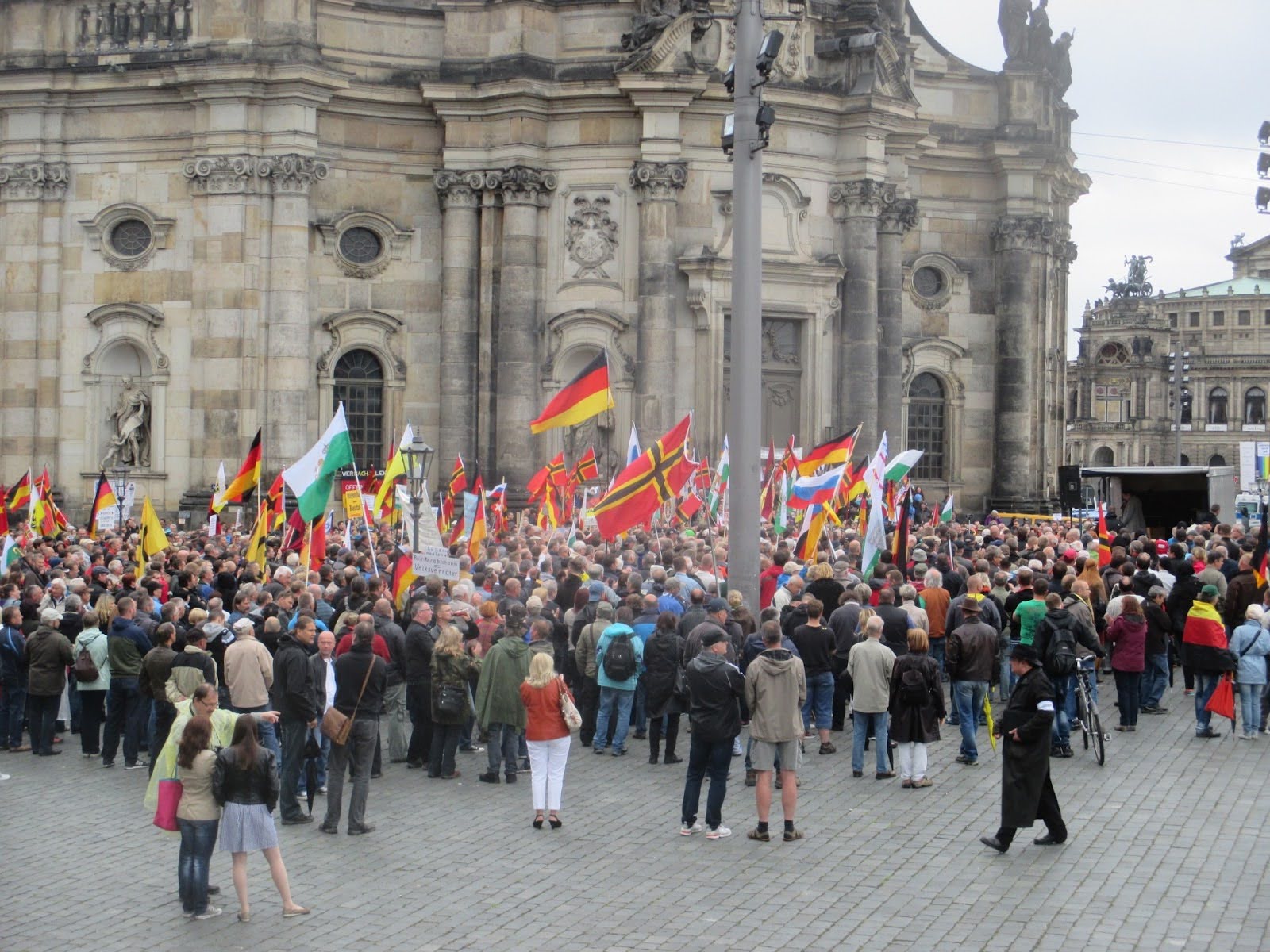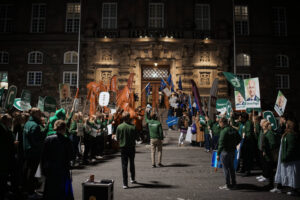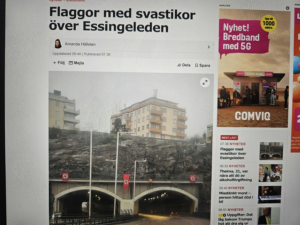The final PEGIDA demonstration was held in Dresden, Saxony, on October 20, 2024. This was the 250th rally since the movement began in October 2014. For a decade, PEGIDA remained active in Dresden, earning international attention. The New Yorker once described it as “Germany’s Strange New Right Wing.”
As a far-right and racist street movement, PEGIDA played a significant role in the growth and radicalization of Germany’s broader far-right landscape. The acronym PEGIDA stands for Patrioten gegen die Islamisierung des Abendlands (Patriots Against the Islamization of the Occident).
Origins and Development of PEGIDA in Dresden
The inaugural PEGIDA demonstration took place on October 20, 2014, in Dresden, drawing 350 participants. The initial protest was sparked by images of a left-wing Kurdish protest against ISIS, which PEGIDA’s founders falsely interpreted as an Islamist demonstration.
The founder of PEGIDA, Lutz Bachmann, born in 1973, has a criminal record with 22 entries, including burglary and drug dealing, according to Sächsische Zeitung. Bachmann’s legal troubles began in 1995, leading to a 3.5-year prison sentence for various crimes. In 1997, he fled to South Africa, only to return and surrender to German authorities in 2000. In 2009, he was caught with cocaine and, in 2010, received a two-year probation sentence for drug trafficking. Bachmann was also convicted for inciting violence at PEGIDA demonstrations. In October 2019, he made controversial remarks about his political opponents: “Supporters of these enemies of the people […] should go into the ditch. […] Then we’ll fill in this ditch.”
From October 2014 onward, PEGIDA demonstrations were held every Monday, initially without signs, slogans, or speeches. The movement quickly gained momentum, and by November 10, 2014, up to 2,000 people participated in the fourth PEGIDA demonstration. Parallel to PEGIDA in Dresden, right-wing hooligans organized under the banner “Hooligans against Salafism” (HoGeSa), though the group disbanded in 2015. In its early days, PEGIDA also garnered support from the Dynamo Dresden soccer team. While PEGIDA was always a racist street movement, it became further radicalized with the increase in refugee arrivals in 2015. This hardening of the movement’s core continued to fuel street protests in subsequent years.
By the end of 2014, offshoots began forming in several cities, particularly in Saxony, aiming to replicate the original PEGIDA’s success. For example, “Leipzig against the Islamization of the Occident” (LEGIDA) was established, with similar movements emerging in cities like Berlin, Chemnitz, Görlitz, Karlsruhe, and Munich.
The movement peaked on January 12, 2015, during the 12th PEGIDA demonstration, which drew up to 20,000 participants. Simon Teune, a movement researcher at the Wissenschaftszentrum and TU Berlin, referred to PEGIDA 2014 as “the largest racist mobilization in the history of the Federal Republic of Germany.” Although counter-protests were typically smaller than PEGIDA’s rallies, antiracist and antifascist demonstrations began almost immediately. Since 2015, the “Herz statt Hetze” alliance has organized these protests.
From 2017 onwards, PEGIDA gradually faded into obscurity. Demonstrations became increasingly sporadic, with fewer participants. By then, PEGIDA had effectively “died” or was overshadowed by the small far-right party Freie Sachsen in Saxony.
Lutz Bachmann emigrated to Tenerife, Spain, in September 2016, returning to Dresden only for occasional demonstrations or court cases. In October 2024, Bachmann announced plans for “new formats” starting in January or February 2025, though it remains uncertain whether these plans will come to fruition.
PEGIDA and Violence
Although PEGIDA claimed to distance itself from violence and racism, the movement fostered an environment where racist perpetrators felt emboldened to carry out violent acts. In its early years, violent neo-fascists participated in PEGIDA demonstrations, with attacks on left-wing counter-demonstrators, journalists, and migrants. PEGIDA’s early rallies in Dresden were often viewed as hostile zones, particularly by those opposing the movement.
In October 2015, a group of 100 hooligans attacked counter-demonstrators, migrants, and police officers, further cementing PEGIDA’s association with violence. Hardcore neo-fascists took advantage of PEGIDA’s momentum to organize and operate under its shadow. One example is the neo-Nazi group Freie Kameradschaft Dresden, which publicly displayed a banner at a PEGIDA rally in 2016 and carried out attacks on left-wing activists and migrants. Members of the Identitarian Movement of Germany also frequently used PEGIDA demonstrations as platforms for marching and recruitment.
In the fall of 2016, Nino K., a former speaker at a PEGIDA rally in Dresden, carried out a bomb attack against a mosque in Dresden. On August 31, 2018, he was sentenced to 9 years and 8 months in prison for attempted murder, aggravated arson, and the production of incendiary devices.
PEGIDA and the AfD
The relationship between the far-right party Alternative for Germany (AfD) and PEGIDA went through several distinct phases. Initially, the AfD kept its distance from PEGIDA until 2015. However, hardliners within the party advocating for closer ties with far-right street movements gained influence over time. They sought to position the AfD as a movement-oriented party, some even referring to it as the “PEGIDA party.”
The demands made by PEGIDA in 2015 closely aligned with the AfD’s state election manifesto. However, after a period of rapprochement, tensions emerged, leading to repeated attempts at distancing. At one point, PEGIDA’s organizers considered founding a rival far-right party, the Freiheitlich Direktdemokratische Volkspartei, signaling friction between the two groups.
A notable incident occurred shortly before the state elections in Saxony on September 1, 2024, when a planned PEGIDA demonstration in Dresden was canceled. The AfD’s federal leadership reportedly prohibited the participation of AfD and Junge Alternative (JA) members, likely to avoid potential scandals.
Despite fluctuating levels of direct cooperation, PEGIDA played a significant role in normalizing racist rhetoric in public discourse, particularly in its early years, thereby paving the way for the AfD’s rise. PEGIDA also popularized terms like Lügenpresse (lying media), accusing mainstream media of spreading falsehoods and contributing to widespread mistrust of traditional journalism.
International networking and export attempts
PEGIDA quickly developed an international network, facilitating the exchange of speakers and ideas between Dresden and far-right movements abroad. Prominent far-right figures such as Geert Wilders (Netherlands), Tommy Robinson (England), Ignaz Bearth (Switzerland), Martin Sellner (Identitarian Movement Austria), and H.C. Strache (Austria) spoke at PEGIDA demonstrations in Dresden.
For example, a statement from the anti-Muslim Dutch politician Geert Wilders was read aloud during a rally on January 25, 2015, and Wilders made a personal appearance at the 23rd PEGIDA demonstration on April 13, 2015. Similarly, on October 19, 2015, Vincenzo Sofo from Italy’s far-right Lega Nord addressed the Dresden crowd, followed by Filip Dewinter and Anke Van der Meersch from Belgium’s far-right Vlaams Belang on December 7, 2015.
Attempts at Europeanization
The growth of PEGIDA inspired attempts to replicate its model in other countries. The Dresden organization officially sanctioned some offshoots while others operated independently. A Europe-wide PEGIDA day of action on February 6, 2016, was an effort to consolidate these efforts. Ultimately, PEGIDA failed to create a lasting international movement.
One notable split-off, Fortress Europe, was founded in Prague on January 23, 2016, by former PEGIDA activist Tatjana Festerling. This alliance organized demonstrations until February 2017 but failed to achieve significant traction.
PEGIDA branches existed at times in Australia (PEGIDA Australia), Austria (PEGIDA Austria), Belgium (PEGIDA Vlaanderen, Pegida Wallonie-Bruxelles), Bulgaria (PEGIDA Bulgaria), Canada, Czech Republic (PEGIDA-Cesko), Denmark (Pegida DK), Eire (Pegida Ireland), Finland (PEGIDA Suomi), France (Resistance Republicaine), Great Britain (Pegida GB, Pegida Scotland, Pegida Wales), Estonia (PEGIDA Estonia), Hungary (Pegida-Hungary), Iceland (Pegida Iceland), Macedonia (Pegida Macedonia), Netherlands (PEGIDA Nederland), Norway (Pegida Norge, Pegida Norway), Poland, Spain (Pegida Spain), Sweden (PEGIDA Sverige), and Switzerland (PEGIDA Schweiz).
Most of these branches were short-lived, with some existing only as online entities. Demonstrations occurred in Amsterdam, Birmingham, Bordeaux, Bratislava, Canberra, Copenhagen, Dublin, Graz, Montpellier, Prague, Saint-Brieuc, Tallinn, Vienna, and Warsaw.
Personal Connections
PEGIDA’s networking extended beyond speeches and demonstrations. On May 8, 2015, Lutz Bachmann met with members of the Russian nationalist motorcycle club Nachtwölfe (Night Wolves) in Torgau, Saxony, further illustrating PEGIDA’s transnational reach within the far-right milieu.








